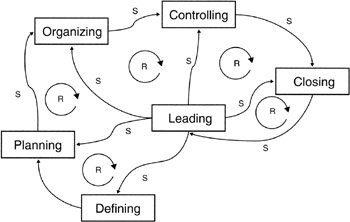Simple Steps
Developing a systemic view to lead a project requires following a few simple steps. These steps, however, are not easy to implement because they require a paradigm shift.
-
Identify the major elements of the project. These may be functions or activities performed, key individuals or organizations, and significant relationships among each other.
-
Try to develop an overall sense of the behavior pattern for a system. In this case, it is a project. Typically, a project performs many interrelated functions or processes, such as defining, planning, organizing, controlling, closing, and leading. The relationships frequently interact with each other, depending on the sequence of phases, for example. Some projects might also be on a crashed or fast-track basis, which can affect how the elements interface with one another.
-
Identify the type of systems diagramming approach to apply, e.g., object oriented, process, data, causal , or hybrid. The key is to pick the most comfortable approach for understanding the dynamics and workings of a project.
-
Identify areas in the diagram that can provide key leverage points to influence results. The leverage points will be determined by the topic, issue, or problem to address.
-
Determine the desired decision or action. This determination requires pinpointing where in a system this decision or action begins, which feeds the next step.
-
Determine the downstream effects of a decision or action. Downstream effects may be positive or negative, balancing or reinforcing , or a combination of both.
-
Address anticipated consequences, e.g., downstream impact of a decision or action. Consequences may be explicit or implicit. Also, remember that any handling of a consequence may result in additional impacts that could necessitate decision or action.
Causal loop diagramming allows us to see the relationships among different processes or functions of projects and their consequences. By viewing a project from a leadership perspective, the dramatic impact becomes apparent.
For example, Figure 5.3 shows the relationships among the major processes of project management. Leading affects all the processes of project management, from defining to closing. In turn , each process affects other processes, e.g., planning enables organizing to occur more efficiently and effectively. The relationships also reinforce each other, e.g., more efficient and effective planning usually begets more efficient and effective organizing and vice versa.

Figure 5.3: Systemic View of the Processes of Project Management.
EAN: 2147483647
Pages: 169